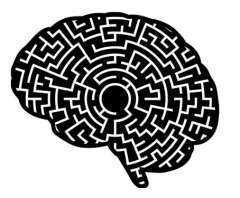The Garden of Forking Paths
Winter 2018

“I leave to various future times, but not all, my garden of forking paths.”—Jorge Luis Borges
In The Garden of Forking Paths, Jorge Luis Borges describes a labyrinth of paths and directions of alternate realities. To those of us who study the brain, The Garden of Forking Paths, and indeed all the short stories in Borges’ collection, Ficciones, has seemed a metaphor for the mind. Our patients experience disorders of thought and logical expression, distortions in perception and memory, and in the serial execution of movement or of future plans. A stroke, a progressive dementia, or recurrent headaches redirect a life’s pursuits into various futures, often along unplanned or unexpected pathways. To map the garden of forking paths is to understand the brain and its diseases. This issue of the Chair’s Report will explore one aspect of this metaphor: how we identify new treatments for the complex diseases of the brain.
To identify the causes and to develop new therapies for neurological diseases requires the discovery of paths in the brain that disrupt its normal function. Alzheimer’s disease is caused by abnormal accumulations of misfolded proteins. Multiple Sclerosis is caused by abnormal pathways of immune expression. Migraine occurs in a complex interplay of disordered brain signaling, sensory input, and blood flow. In each of these brain diseases we have developed therapies that mitigate some symptoms or slow progression, but we have not developed treatments that stop the disease. In the lab or clinic, new discoveries further our understanding of the disease, but also open up many additional questions and often highlight even more areas of uncertainty. The science of discovery in brain diseases is not limited by too little an understanding of which directions to take, but by too many paths to take at any one time.
In Borges’ The Garden of Forking Paths, the labyrinth is in time, not in space. Many possible directions in a person’s life exist, in the past and in the future. The crucial distinction for Borges is that all of these paths are available and may be experienced or taken at the same moment. The Garden of Forking Paths is the nearly infinite possibility of personal experiences that could unfold with each moment, decision, or interaction: “This web of time—the strands of which approach one another, bifurcate, intersect or ignore each other through the centuries—embraces every possibility” in how a human being relates to his or her world.
To paraphrase Borges as this relates to Neurology, a disease “creates various futures, various times, which start others that will in their turn branch out and, in other times, bifurcate. This is the cause of contradictions.” To understand a disease in the brain, we must go beyond the consideration of a single experiment, a single pathway, or a single decision point at one time. A more complete understanding of diseases of the brain requires taking multiple paths of study at the same time, so that apparent contradictions are approached from many different directions. Traditional funding sources, such as the National Institutes of Health, support cautious, linear steps in research and lead to singular steps ahead in disease progress.
Philanthropic support of neurological research provides innovative clinicians and scientists the opportunities to map the many disordered pathways of disease at the same time, and then link these pathways to a greater understanding.
In this issue of the Neurology Chair’s Report, we highlight the gift of Wendy and Leonard Goldberg to the UCLA Goldberg Migraine Program and how it has accelerated migraine research and clinical care in many directions at once. Under the leadership of Andrew Charles, M.D., Meyer and Renee Luskin Chair in Migraine and Headache Studies, the UCLA Goldberg Migraine Program comprises a team of clinicians, scientists, nurse practitioners, psychologists, and staff who develop new treatment approaches for migraine, determine innovative brain stimulation techniques to disrupt pain signaling, identify mechanisms of migraine pathways within brain cells, and provide integrative clinical care for this disabling neurological disease. The generous support of Wendy and Leonard Goldberg and their group of friends and colleagues has funded a multidirectional set of studies that identifies migraine causes and treatments in an emerging map of the disease: mapping the labyrinth from many directions.
Under the direction of experienced clinician-scientists and with partnerships from supportive friends in Neurology, the garden of forking paths is understood with greater clarity because it is understood in all its unexpected diversity and contradiction at the same time. We are sincerely grateful to each contributor who has made these advances possible.